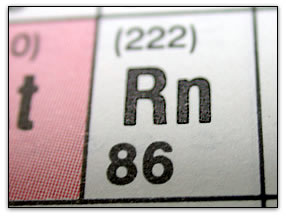 Radon gas is still an item that should be of some concern to home owners.
Radon is a colorless, odorless gas produced by the decay of elements in the soil.
It usually enters a home by seeping through cracks in the basement, foundation, sump pump
or pipes and can be detected through proper testing. Recently, reports
surfaced about radon being emitted from certain types of granite
countertops. Radon gas is still an item that should be of some concern to home owners.
Radon is a colorless, odorless gas produced by the decay of elements in the soil.
It usually enters a home by seeping through cracks in the basement, foundation, sump pump
or pipes and can be detected through proper testing. Recently, reports
surfaced about radon being emitted from certain types of granite
countertops.
Testing radon levels is one of the most difficult environmental problems
to accurately measure. Reasons for this include interference from such
factors as air movement, cigarette smoke, water table levels, barometric
pressure and even the season of the year, all of which can affect the
readings.
Although difficult to measure, radon problems are relatively easy and inexpensive to
mitigate when compared to correcting other environmental problems.
Types of testing devices can either be passive or active. Passive devices include charcoal
canisters, alpha-track detectors and charcoal liquid scintillation. These testing devices
are available at hardware and houseware stores and generally require at least 48 hours to
complete.
Active devices include continuous radon monitors and continuous working level monitors,
and require operation by trained testers. Many of these devices provide a continuous
report of radon levels present, revealing any unusual or abnormal swings in the levels
during the test period (usually 48 hours or more). These devices are specifically designed
to deter and detect test interference. Although these tests may cost more, they ensure a
more reliable result.
Whichever testing method is employed, make sure the test is approved by
the Environmental Protection Agency (EPA). Once the level
of radon is known, it may be necessary to mitigate the problem. It may be as simple as
sealing any cracks in the floors or walls of the basement, foundation and/or crawl space
since that is how the gas enters the home in the first place. Or, the air from the
basement or crawl space may need to be vented. A state-licensed radon mitigator can more
fully discuss these and other options.
In the United States, the radon threshold for concern is 4.0 picocuries per liter or
higher, whereas a picocurie is one-trillionth of a curie -- the measure of
radioactivity found in a gram of radium. A measurement at these levels
indicate some type of action should be taken to avoid possible health
threats.
 Printer Printer
Friendly |
|

